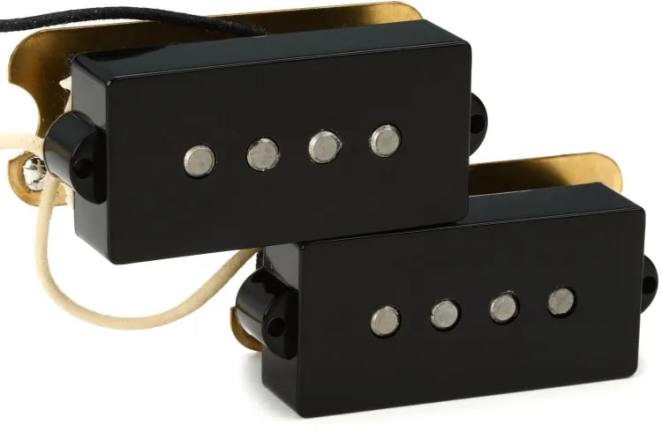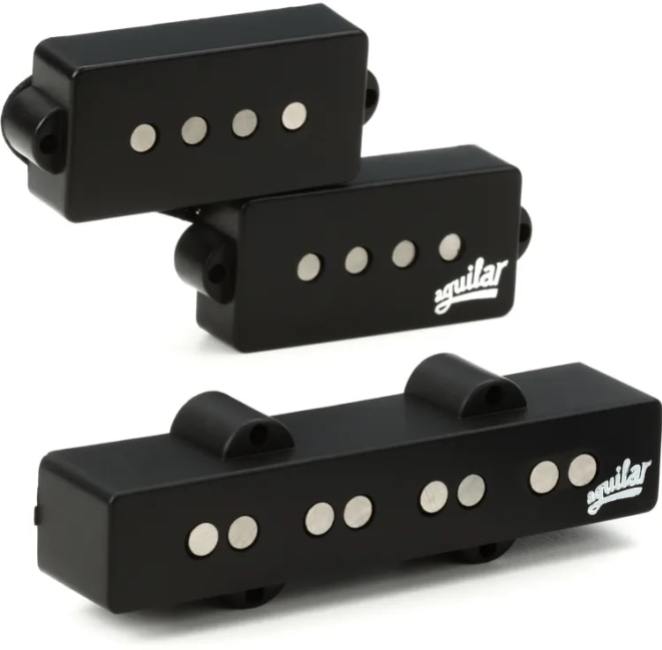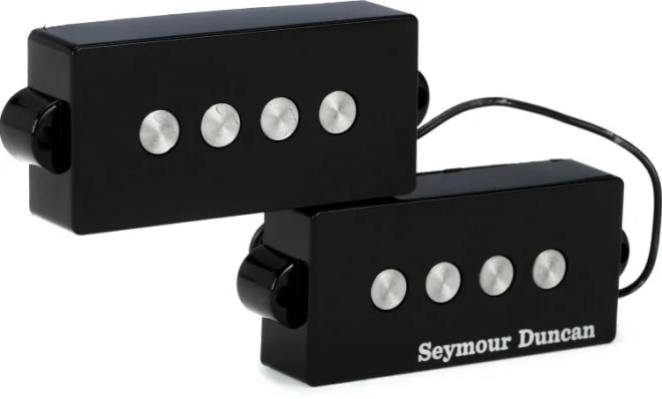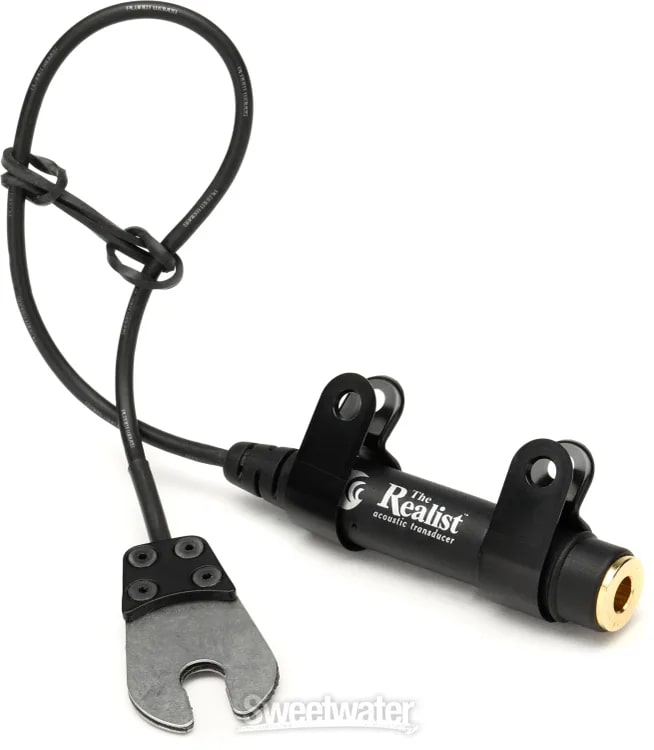When you buy through our links, we may earn an affiliate commission.
Not happy with your bass guitar's sound? Swapping out the pickups in your bass guitar is one of the go-to modifications to change up and experiment with your tone.
It might be because you're not quite happy with the pickups currently installed, or you're looking to sculpt a new tone altogether and want to explore new sonic ground, but regardless of the reasoning, there are a lot of choices for bass players when it comes to finding the best bass pickups for your sound.
In this guide, we run over some ideal pickups for electric bass guitars as well as standup basses, why we like them, and why they might be the perfect choice for you.
Our top pick for the best bass pickups overall is the Original '62 pickups from Fender. These are the perfect upgrades for P-bass players to elevate their instrument's sound to the next level.
Not a P-bass player? We've got picks for everyone on this list, from humbuckers to piezos. We've also included a handy buyer's guide to help you better navigate the world of bass guitar pickups and make the best possible purchase for your needs.
Now, without further ado, let's get to the list.
Quick Summary of the Best Bass Pickups
- Fender Original ‘62 (Best Bass Pickups Overall)
- Aguilar AG 4P/J-HC (Best Single Coil Bass Pickup)
- DiMarzio Split P (Best Humbucker Bass Pickup)
- Seymour Duncan SPB 3 (Best Split Coil Bass Pickup)
- EMG PB K (Best Active Bass Pickups)
- Realist LifeLine (Best Piezo Bass Pickup)
- Roland GK-3B (Best MIDI Bass Pickup)
Best Bass Pickups
1. Best Bass Pickups Overall – Fender Original ‘62

SPECS
- Type and Format: Single coil, P-style
- Magnet: Alnico V
- Features: Passive, split-coil
Who else but Fender is a top choice when it comes to the best P-Bass pickups? The Fender Precision bass lives in legend for a reason—they got it right the first time. Across multiple genres, it has become the iconic four-string sound. There are many different types of split single-coil pickups for Precision basses, and the ‘62 is one of the most popular.
It’s an entirely faithful reproduction of the '62 Precision bass pickup in terms of sound and design. The vintage tone is centered around an enamel-coated magnet wire with a fiber cloth output and fiber bobbin.
Due to this type of design, the flush-mounted pole pieces provide an even response from string to string with a focused and dynamic sound thanks to the Alnico V magnets.
The traditional P-bass pickup sound just works across almost every genre, and regardless of the quality of the bass you’re using, these are excellent tonal upgrade that comes with everything you need to get them installed and playing right away to upgrade your bass sound.
2. Best Single Coil Bass Pickup – Aguilar AG 4P/J-HC

SPECS
- Type and Format: Single-coil, PJ
- Magnet: Alnico
- Features: Passive, split-coil, and single-coil
There are two main types of single coils - split coil pickups and single coil. The former is used in Precision bass designs, the latter in Jazz bass designs.
But there is a third type - the PJ. This combines both types of single-coil bass pickups to offer a variety of sound combinations.
Aguilar makes some of the best bass gear, and this set makes for a great retrofit of aftermarket pickups. Alnico V pickups provide great lows for a neck pickup and scooped mids of the bridge pickup.
They’re low noise, play well with all types of amps, and provide the perfect feel for whatever style you play. And 60-cycle hum is a non-factor.
3. Best Humbucker Bass Pickup – DiMarzio Split P

SPECS
- Type and Format: Humbucker, P-style
- Magnet: Ceramic
- Features: Passive, split-coil
DiMarzio has been one of the premier pickup manufacturers since 1972. And while they’re best known for their guitar models, their bass pickups are just as good. This double-blade P-style humbucker pickup offers a great attack that remains smooth and balanced.
The EQ profile is tailored to provide an extended range for single pickup basses, and the ceramic magnet provides plenty of output. The mids are a bit scooped, with an emphasis on the low end and a moderate treble range.
It won’t suit everyone’s style or sound, but in terms of what it does, it does very well - and that includes the purest metal bass sounds. The sleek obsidian look fits right in with a number of different color finishes and can go from heavy to articulate, depending on how it’s dialed in.
4. Best Split Coil Bass Pickup – Seymour Duncan SPB 3

SPECS
- Type and Format: Single coil, P-style
- Magnet: Alnico V
- Features: Split coil
The split coil design was one of the earliest types of bass pickups, and it's just as popular today. This type of pickup consists of a single coil split in half, with each covering two strings (on a four-string bass).
The Precision bass design is the most popular that uses split-coil pickups, but you'll find them in a lot of models from varying manufacturers. The Seymour Duncan SPB isn’t trying to reinvent the wheel; it’s just really good at what it does.
And at $99, it’s a great, affordable bass pickup for even the most casual bassist. The pole pieces are a quarter inch in diameter, which broadens the magnetic field and thus opens up the frequency range.
The high output and strong attack are great for rock, but it’s a tonally versatile pickup that can handle any genre thrown at it.
5. Best Active Bass Pickups – EMG PB K

SPECS
- Type and Format: Single coil, P-style
- Magnet: Ceramic
- Features: Split coil, solderless
When it comes to active pickups for guitar and bass, EMG has been leading the charge for years. The distinct sound and look of their active pickups resonate with musicians in all genres.
Active pickups have certain advantages over passive pickups. They have a much stronger low end, and the ceramic magnets give a strong high end. One of their best features is they're solderless.
A pre-wired volume/tone control set is included, as well as the output jack, battery compartment, and adjustment screws for fine-tuning the angle.
6. Best Piezo Bass Pickup – Realist LifeLine

SPECS
- Type and Format: Piezo contact pickup
- Magnet material: N/A
- Features: Self-powered, good sound regardless of volume, attaches without glue or fastening, fits onto most bridges without specific changes required
Piezoelectric pickups work by using a crystal to sense vibration. They are much different than magnetic pickups and thus are used for different applications. And when it comes to fitting a pickup on an acoustic or standup bass, they are a terrific choice.
The sound of Realist LifeLine piezo pickups is focused and adds a strong presence without losing any sound fidelity. One of the best features is that it easily mounts at the adjuster, so there’s no risk of instrument damage from glues or fasteners.
7. Best MIDI Bass Pickup – Roland GK-3B

SPECS
- Type and Format: MIDI Bass Pickup
- Magnet material: N/A
- Features: Passive, bridge-mounted
MIDI pickups are a bit of a mystery to a lot of bass players because the only reason to use them is when running a synthesizer system.
And though there are some pedals that can replicate the sounds, synthesizer systems allow for access to tones that just aren’t possible otherwise.
It works with synth systems like Roland’s V-Bass and GR-20 v.2, meaning it works for bass and guitar. You can also set it for access to standard bass sounds, synth sounds through the external system, or a blend of both.
Installation is easy, the only caveat being it requires a GKC-5 or GKC-10 13-pin cable that’s not included with it.
Best Bass Pickups Buyer's Guide
Pickup Type
The type of pickups available to you are based on two main factors - the sound you're going for and how the body of the bass is routed.
There are two main types of bass guitar pickups: single coils and humbuckers. Single coils provide a bright and clear tone, but they are prone to picking up (pun intended!) noise in the environment like 60Hz cycle hum, radio waves, electronics like computers, and even fluorescent lighting.
With advances in technology, it’s not as big of an issue anymore, and there are plenty of noiseless single-coil bass pickup models available.
Just like guitar pickups, humbucker designs are two single coils placed together at opposite polarities to negate 60Hz cycle hum. They have a “fatter” sound, less noise, higher output, and more sustain than single coils.
The split coil pickup is another type. These are the iconic pickups used on Fender’s Precision Bass line and many others. They are two single coils side by side, with the pole pieces each covering two strings.
Pickup Format
This can be thought of as the physical design of the pickup. Two of the most popular and identifiable types of pickups are P-style and J-style, most commonly associated with Precision and Jazz bass designs, respectively.
But there are also humbucker, piezo, and MIDI pickups. All serve a different purpose, offer different sounds and tonal profiles, and work best for different genres.
Magnets
Pickups are made from different types of magnets. One of the most popular magnet types is alnico, an alloy made from aluminum, nickel, and cobalt.
Alnico pickups provide a smooth and balanced tone that works well in guitars and basses. They come in multiple variations, using a number system to describe the different combinations of metals in the alloy. Each has a different level of strength and tone.
Alnico 2 is fairly weak, with lower output and vintage sound. Alnico 3 is the weakest of all, with low output and a “soft” sound. They have strong treble and are great for clean tones.
Alnico 4 is stronger than 2 and 3 and provides a flat, balanced sound. They work well with the guitar itself to bring out the best qualities of the instrument. Mids are balanced, and lows and highs are tight. It’s one of the most versatile types of Alnico pickups.
Alnico 5 pickups have a high output, great for heavy musical styles. Lows and highs have more emphasis while remaining balanced. They’re generally considered to be the most versatile of all alnico alloys.
Lastly, alnico 8 is the strongest and thus has the highest output. Due to their strength, they have strong lows, robust midrange, and broad highs. These are best used in styles like metal, prog, and heavy rock, where distortion is ubiquitous with the style.
Ceramic magnets gained popularity in the 1960s. They were originally used on lower-end guitars due to their production affordability, but they have a sound all their own. They’re brighter and harsher than Alnico pickups and usually have a hotter output.
The high-end and upper midrange are strong; some might even say strident. Low-end cuts and overall dynamics are fairly compressed.
It’s certainly a tonal preference, but ceramic pickups have a lot of uses. They’re popular in heavier styles like hard rock and metal because they handle distortion well. EMG, one of the most popular active pickup manufacturers, uses ceramic builds in a lot of their models.
These aren’t the only types of magnets used in pickups, but alnico and ceramic are by far the most common.
Passive vs. Active
These are the two main categories of bass pickups and have one primary difference. Active pickups require battery power, and passive pickups don’t. Both have their own distinct sound and advantages and disadvantages.
Passive pickups were the first to come to market. Their tone can be described as having a warm sound that's full and dynamic. Most only offer very specific passive tone controls over bass and treble. Since they’re passive, you can only attenuate frequencies.
This isn’t a bad thing; it just means there are fewer equalization options. Due to the larger magnets used in passive pickups, they’re more susceptible to interference and noise.
Active pickups use a preamp powered by one or two 9-volt batteries. Active systems give greater tone control and allow for frequency cut and boost.
Exact level of control is determined by the preamp. Some only offer bass and treble, and more robust preamps include midrange and additional features.
Active pickups have more output and reduced capacitance than passive systems. Magnets are smaller and are less prone to outside noise.
Manufacturer
Like all types of gear, the quality and reputation of the manufacturer play a huge part in the quality of pickups. Most guitar companies sell pickups separately, with Fender, Gibson, and PRS being two of the most popular.
Then there are infamous third-party manufacturers like Seymour Duncan, DiMarzio, EMG, and Fishman. Some companies like Aguilar and Bartolini only make aftermarket bass pickups.
Boutique pickup builders have popped up everywhere, and while they tend to come at a higher cost, their bespoke, often hand-wound models have caught the ears of musicians everywhere.
Lollar, Fralin, Mojotone, and Bareknuckle are just a few of the respected boutique winders that make incredible pickups.
Frequently Asked Questions (FAQs)
What is the best pickup for bass?
The best pickup for your bass sound depends on your style, the sound you’re chasing, and the type of basses you play. Single coils are preferred by a lot of rock, pop, funk, and blues bassists, while humbuckers are great for high output, heavy styles like metal and hard rock.
You also have to consider the body route in your bass and choose pickups that will fit into it accordingly.
Are active bass pickups better?
When it comes to music gear, “better” is always subjective. Active bass pickups are hotter than single coils and provide a fatter and wider sound with higher output. They’re generally best suited for heavier styles of music like hard rock and heavy metal, but you’ll often see them used in genres you might not expect, like funk and jazz.
Due to the active preamp buffering, bass pickups can drive long cable runs without the introduction of tone suck and capacitance.
This means that they don’t experience any degrading of sound or introduction of outside noise and interference.
What are the different bass pickups?
Active and passive pickups come in a few different variations. Just like guitar pickups, the most common are single coils and humbuckers. But there are also split coil and double coil models.
Each type of bass guitar pickup comes in different variations as well, so bass guitar players have no shortage of options when it comes to selecting the best style of pickup for their specific sound.
How much does it cost to replace a bass pickup?
When it comes to replacing a bass pickup, you have two things to consider - the cost of the replacement pickup itself and the cost to have it installed if you have to take it to a tech or luthier.
Quality aftermarket pickups generally range from just over $100 to a few hundred in price. The cost of paying a professional to install new pickups can vary greatly and depends mostly on whether they charge per hour or a flat fee per project.
Conclusion
Bass is a fundamental element in almost every genre of music.
There are a vast variety of different types of basses, and the types of pickups bass players can install to replace the stock pickups in a bass is just as wide a category.
So, no matter what sound you’re going for or the type of bass guitar you prefer to play, upgrading or augmenting your sound is as easy as doing the proper research to find the type of pickups that will get you there.
Amplify the beauty of your classical guitar! Explore our top selection of the best pickups for classical guitars.
Don't settle for ordinary sound! Browse our collection of the best single coil pickups and transform your guitar's performance.
Enhance your bass tone! Explore our selection of the best jazz bass pickups for a classic and rich sound.
